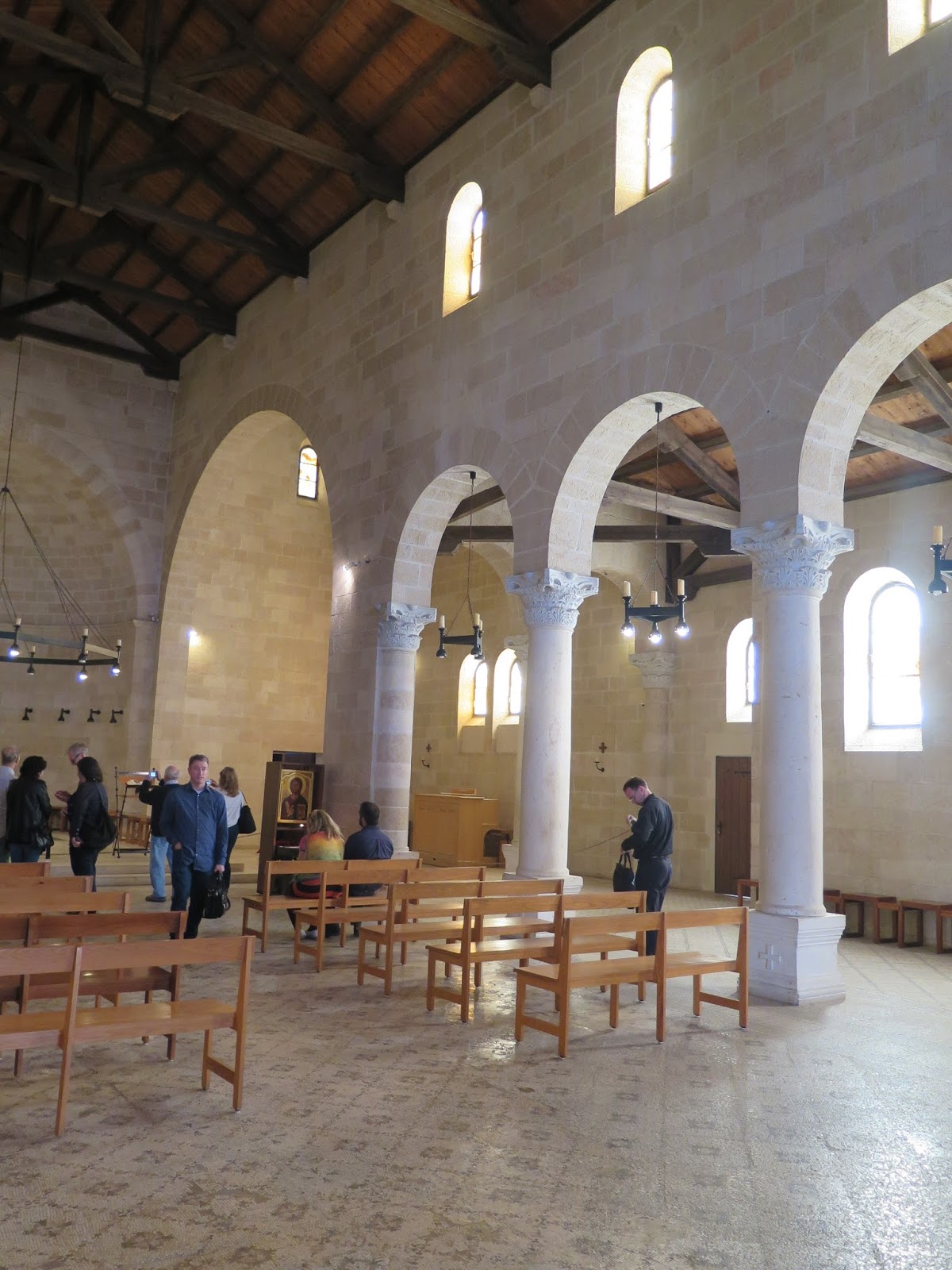Tabgha and is an area situated on the northwestern shore of the Sea of Galilee in Israel at the base of the Mount of Beatitudes.
We left the Mount of Beatitudes and walked to two Tabgha churches. One commemorates the multiplication of the loaves and fishes and the other honors Jesus' command for Peter to "Feed my sheep." The Church of St. Peter's Primacy is the basalt church in the distance.
It is also the traditional location for the calling of Christ's disciples.
In front of the altar is a large rock which has been called the
"Table of Christ."
(Read the story below)
On the shore, Jesus had prepared a charcoal fire for the fish and provided bread. They had breakfast together on the shore and this has been traditionally believed to have taken place on the large rock which is incorporated inside and extends to the outside of the church. (John 21:9)
Statue below: "Feed My Sheep"
We walked along the shore and thought of the many miracles that happened here during Jesus' ministry. Our grandchildren were in awe and standing here was quite sobering to them.
Between the Late Muslim period and 1948, Tabgha was also the site of a
Palestinian Arab village.
Tabgha is a popular fishing spot of the locals because of its famous “seven springs."
On the lake side of the church are six heart-shaped rocks or steps which tradition says are stones "where the Lord stood." It is not known when they were carved but it may have been in the 2nd or 3rd century when this area was quarried for limestone. Nevertheless, they were interesting and thought provoking. When the tide is in, these rocks are covered and you can't see them.
Photo: The newer Church of the Multiplication of the Loaves and Fishes was dedicated in 1982. It was built to commemorate when Jesus of Nazareth fed 5,000 from the loaves and the fishes. However, a much smaller church was first built on this site in 350.
The scripture account of the loaves and fishes says this miracle happened in a "remote place" on the shore of Galilee. It felt good to be on the shore of the Sea of Galilee and helped our grandchildren to have a better understanding of the setting where many miracles happened. Our family could have stayed here for hours but it was time to see the other church at Tabgha.
The scripture account of the loaves and fishes says this miracle happened in a "remote place" on the shore of Galilee. It felt good to be on the shore of the Sea of Galilee and helped our grandchildren to have a better understanding of the setting where many miracles happened. Our family could have stayed here for hours but it was time to see the other church at Tabgha.
The Church of the Multiplication of the Loaves and Fishes is run by the Roman Catholic Church. Tragically in June, 2015, this church was set on fire in a hate crime but has since been restored. When we were in Nazareth a few months ago, another church had been set on fire.
The miraculous feeding of five thousand people is described in Mark 6:30-44 just before Jesus walked on water. According to the scripture, a crowd of 5,000 had come to hear Jesus talk and He fed them with only five loaves of bread and two fish.
Under the altar table is a block of limestone tradition says is the "table of the Lord." Many years ago, pilgrims were permitted to chip away at it! In front of the altar is a famous restored mosaic of two fish flanking a basket of loaves. This Byzantine depiction of a bread basket with two fish represents the overflowing love of God to feed the thousands. The artist of this mosaic was apparently not acquainted with the fish in the lake because none have two dorsal fins.
Once again, I am continually amazed by the beautiful mosaics we have seen on floors, walls and even on ceilings in Israel.
Looking from the front of the church to the back.
Outside the church was what we thought what might be I wish these rocks could talk as we might hear some really interesting stories!
One more amazing day in Israel but what was most amazing was the opportunity to share it some of our family.





























You did a great job of narrating these places and taught me some new things about St. Peter's Primacy Church. We are so happy to see that the Tagbha church for the Multiplication of Loaves and Fishes has been restored. We were sick to hear that it had been burned. Which Church in Nazareth was burned?
ReplyDelete